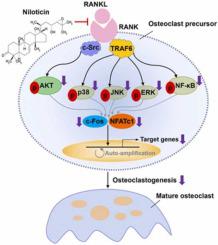Biomedicine & Pharmacotherapy ( IF 6.9 ) Pub Date : 2022-03-29 , DOI: 10.1016/j.biopha.2022.112902 Huanhuan Xu 1 , Yuankan Jia 2 , Jin Li 1 , Xueqin Huang 2 , Li Jiang 2 , Ting Xiang 2 , Yuanhao Xie 1 , Xiaomei Yang 1 , Titi Liu 1 , Zemin Xiang 3 , Jun Sheng 4

|
Dysregulation of osteoclasts or excessive osteoclastogenesis significantly –contributes to the occurrence and development of osteolytic diseases, including osteoporosis, inflammatory bone erosion, and tumor-induced osteolysis. The protein-protein interaction between the receptor activator of nuclear factor (NF)-κB (RANK) and its ligand (RANKL) mediates the differentiation and activation of osteoclasts, making it a key therapeutic target for osteoclastogenesis inhibition. However, very few natural compounds exerting anti-osteoclastogenesis activity by inhibiting the RANKL-RANK interaction have been found. Niloticin is a natural tetracyclic triterpenoid compound with anti-viral, antioxidative, and mosquitocidal activities. However, its role in osteoclastogenesis remains unknown. The present study found that niloticin directly binds to RANK with an equilibrium dissociation constant of 5.8 μM, blocking RANKL-RANK interaction, thereby inhibiting RANKL-induced AKT, MAPK (p38, JNK, and ERK1/2), and NF-κB (IKKα/β, IκBα, and p65) pathways activation, and reducing the expression of key osteoclast differentiation-related regulatory factors (NFATc1, c-Fos, TRAP, c-Src, β3-Integrin, and cathepsin K) in osteoclast precursors, ultimately negatively regulating osteoclastogenesis. These findings suggest that niloticin could serve as a novel osteoclastogenesis inhibitor and might have beneficial effects on bone health.
中文翻译:

尼罗菌素通过阻断 RANKL-RANK 相互作用和抑制 AKT、MAPK 和 NF-κB 信号通路来抑制破骨细胞生成
破骨细胞的失调或过度的破骨细胞生成显着促进了溶骨性疾病的发生和发展,包括骨质疏松症、炎症性骨侵蚀和肿瘤诱导的骨溶解。核因子受体激活剂 (NF)-κB (RANK) 与其配体 (RANKL) 之间的蛋白质-蛋白质相互作用介导破骨细胞的分化和活化,使其成为抑制破骨细胞生成的关键治疗靶点。然而,很少有天然化合物通过抑制 RANKL-RANK 相互作用发挥抗破骨细胞生成活性。尼罗丁是一种天然的四环三萜类化合物,具有抗病毒、抗氧化和杀蚊活性。然而,它在破骨细胞生成中的作用仍然未知。本研究发现尼罗霉素直接与 RANK 结合,平衡解离常数为 5.8 μM,阻断 RANKL-RANK 相互作用,从而抑制 RANKL 诱导的 AKT、MAPK(p38、JNK 和 ERK1/2)和 NF-κB(IKKα /β、IκBα 和 p65)通路激活,并降低破骨细胞前体中关键破骨细胞分化相关调节因子(NFATc1、c-Fos、TRAP、c-Src、β3-整合素和组织蛋白酶 K)的表达,最终产生负面影响调节破骨细胞生成。这些研究结果表明,尼罗丁可以作为一种新型破骨细胞生成抑制剂,并可能对骨骼健康产生有益影响。并降低破骨细胞前体中关键破骨细胞分化相关调节因子(NFATc1、c-Fos、TRAP、c-Src、β3-整合素和组织蛋白酶 K)的表达,最终负调节破骨细胞生成。这些研究结果表明,尼罗丁可以作为一种新型破骨细胞生成抑制剂,并可能对骨骼健康产生有益影响。并降低破骨细胞前体中关键破骨细胞分化相关调节因子(NFATc1、c-Fos、TRAP、c-Src、β3-整合素和组织蛋白酶 K)的表达,最终负调节破骨细胞生成。这些研究结果表明,尼罗丁可以作为一种新型破骨细胞生成抑制剂,并可能对骨骼健康产生有益影响。






































 京公网安备 11010802027423号
京公网安备 11010802027423号